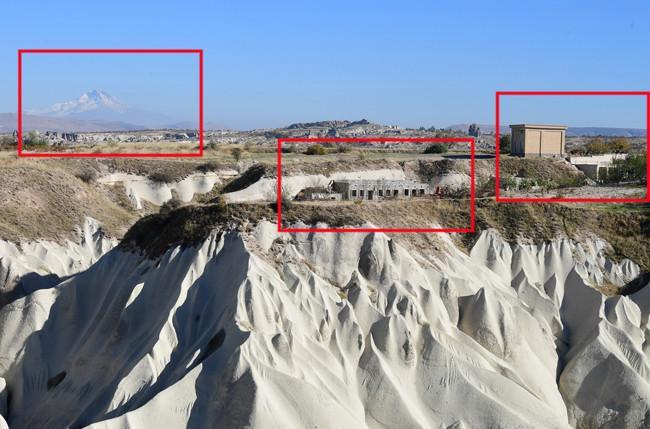
Illegal structures built in the famous Cappadocia region in the Central Anatolian province of Nevşehir will be demolished, according to Turkey’s culture and urbanization ministers, after daily Hürriyet reported illegal construction has increased in numbers following the introduction of the “zoning amnesty.”
“Those [building illegal structures] should not think they will get away with this. Because rotten eggs will be weeded out,” Culture Minister Mehmet Ersoy said during his visit to the scenic region on Nov. 3.
“There are 100 illegal structures determined one by one. All of them will be demolished,” said Environment and Urbanization Minister Murat Kurum, while addressing reporters in the northwestern province of Tekirdağ.
The comments from the ministries came after daily Hürriyet published the complaints from locals about how the Cappadocia region was being “sacrificed” to the zoning amnesty (“imar barışı” in Turkish)—the process for which building registration certificates would be issued for buildings that had been built without licenses and which lack proprietorship certificates.
Hürriyet said many hotel, restaurant and homeowners had applied to the authorities and received a building registration certificate for construction that had not even been completed yet.
“The zoning amnesty is a well-intentioned implementation,” Ersoy said during a visit to Nevşehir Mayor Atilla Seçen.
A mere application to obtain a building registration certificate does not automatically mean the relevant illegal structure will be legalized, he said.
“Those who do not abide by the rules [criteria to be granted a legal permit] will see what they will face later. What they hope for will not be realized. Cappadocia is the ‘pupil of our eyes’ in tourism,” said Ersoy.
“There are a couple of faces of Turkey regarding tourism and Cappadocia is one of them. And we know its value,” said the culture minister.
Seçen confirmed there had been a “plunder” of illegal structures in the region for a while now and the recently issued “zoning amnesty” made the municipality’s fight against such structures more difficult.
“While we are pursuing illegal buildings centimeter by centimeter and facing off against citizens, in one night, our state has passed a regulation of reconciliation [zoning amnesty]. As the municipality, we are trying to stop illegal construction from taking place, but this situation is a dilemma and we are having many problems,” Seçen said.
Kurum also commented on the issue during his visits to the Tekirdağ province, saying the determined 100 illegal structures in the Cappadocia region had all been built after Dec. 31, 2017, which meant they would not be considered for building registration certificates, as according to the relevant provisional article, certificates can be issued for buildings built prior to this date.
“We have filed a criminal complaint against these structures. Our governor’s office is also following this [legal] process. These structures are not within the context of the zoning amnesty. All of these will be demolished,” he said.
The environment and urbanization minister also said approximately 8.5 million people have benefitted from the zoning amnesty so far.
“We do not see the zoning amnesty as a source of income,” said Kurum.
“Approximately 8.5 million of our citizens have benefitted from it. Hopefully this number will reach 14-15 million. There is a significant demand [for it]. We have extended the deadline [for application] to Dec. 31, 2018 [from Oct. 31, 2018],” he said.
The Cappadocia Region is located in Turkey’s Central Anatolian region. It has valleys, canyons, hills and unusual rock formations created as a result of eroding rains and winds of thousands of years on the level, lava-covered plain located between the volcanic mountains Erciyes, Melendiz and Hasan.
It also has troglodyte dwellings carved out of rock and cities dug underground, presenting an otherworldly appearance. The eruptions of these mountains, which were active volcanoes in geological times, have lasted until two million years ago. A soft tuff layer was formed, 150 meters in thickness by the lava in the valley surrounded by mountains.
Cities, empires and religions have risen and fallen around these unique underground havens, yet they remain occupied to this day.
Throughout the ages, the Hittites, Persians, Alexander the Great, Rome, the Byzantine Empire, Ottoman Empire and Turkey have all governed this spectacular region of Central Anatolia.